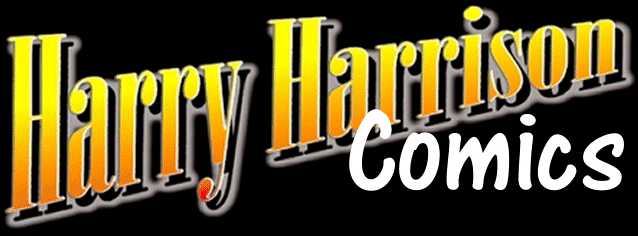
Introduction |
|
After leaving the army in 1945, Harry Harrison enrolled at an art school,
where one of his instructors was Burne Hogarth - when Hogarth left the school
to set up his own Cartoonists and Illustrators School, Harrison and number of
other students went to join him. Hogarth's classes attracted a number of
students who went on to become major names in the comics field: Ernie Bache,
Al Williamson, Joe Pena, Wally Wood, Mike Esposito, Roy Krenkel, Ross Andru,
John Severin, Jerry Kolden...
Whilst attending these classes, Harrison teamed up with Wally Wood, and they began selling artwork to Victor Fox: "We worked together because neither of us could hack it alone," Harrison told Bill Spicer and Pete Serniuk in a 1973 interview for Graphic Story Magazine. "We were a complete team, we did everything together. In the beginning I think he pencilled and I inked, and then he got very good with inking and did the heads and hands. He'd break down the pages very tight with the figures, and we'd pass the pages back and forth each handling certain kinds of wipes... We were illustrating a lot of romance titles, which were big then. Very badly written things, with nine-panel pages and five hundred words in captions and dialogue. Wally lettered so thick we'd have only about one square inch per panel for the drawings." Harrison and Wood, whose artwork was often signed Harrison-Wood, were paid around $23 per page for these ten-page stories, of which $5 per page had to be given as a kickback to the art director who was giving them the commissions. They also provided pencils for one story for Fawcett - "too much work for the money" - and then worked on Blackhawk for Quality, as well as doing several one-off jobs for other publishers. Harrison did the lettering for Crime Does Not Pay. Eventually Harrison and Wood made their way to EC and Bill Gaines - "the first time we got any kind of really decent publisher" - where they worked on a number of romance comics, mostly western romances. Both Harrison and Wally Wood were science fiction fans and wanted to work on SF comics, and so they tried to persuade Gaines to do an SF comic. Eventually Gaines came up with Weird Science. Harrison and Wally Wood finally went their separate ways - "he was a much better artist than me by then... Just like me, [he was] very hard to work with. We all had big egos in comics. We got into a lot of fights, one of the reasons we broke up." - with Harrison carrying on with the EC material for a while, but he finally lost the account - "without Wally I wasn't a very good inker." Harrison then worked mostly for Fawcett, and moved towards packaging comics and magazines. Among these magazines was an imitation of Confidential called Grapevine; an imitation of Mad magazine called Nuts; True Stories of Stamps; and several 'weird' and science fiction titles that lasted only one or two issues, including Captain Rocket. Harrison would edit, write, draw and ink what he could on these titles to keep his costs down. In his book Harry Harrison, Leon Stover mentions an unsigned comic strip called 'Captain Marble Strikes Again,' drawn by Harrison, which appeared in the November 1954 issue of Nuts. When the comics boom ended, Harrison was well-placed to moved sideways from comics work into editing and writing for magazines. There is some overlap here between Harrison's writing and drawing comics, moving into magazine packaging and editing, and his writing for confessions and men's adventure magazines. Curiously, Harry Harrison wrote very few comic stories during this early part of his career, with only a few EC stories coming anonymously from his pen - "I hadn't even thought much about writing then, staying busy with doing artwork. I smuggled stories in and someone else would put their names on them." Among those who took credit for these early Harrison comic strips was Harrison's first wife, Evelyn Harrison. Bibliographic details of Harry Harrison's comic art work are patchy at best, but there are a number of projects underway to build up this information. The details here are taken from Fred von Bernewicz and Grant Geissman's Tales of Terror!: The EC Companion and the Grand Comics Database, with additional details from Graphic Story Magazine #15, Summer 1993. All quotations above, unless otherwise credited, are taken from "Graphic Story Magazine Interview: Harry Harrison" by Bill Spicer and Pete Serniuk, Graphic Story Magazine #15, Summer 1973.
|